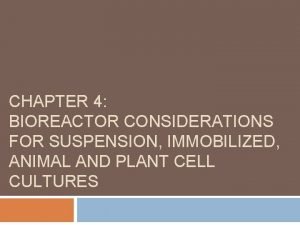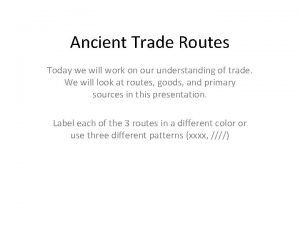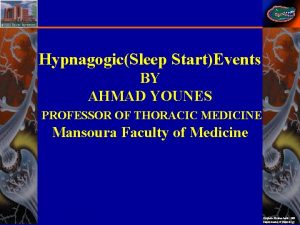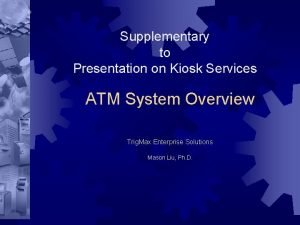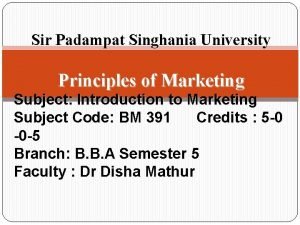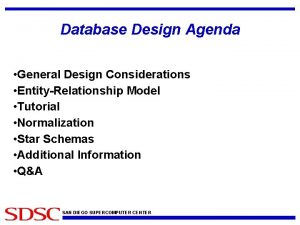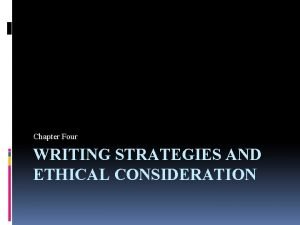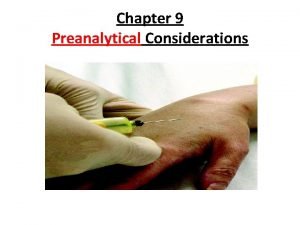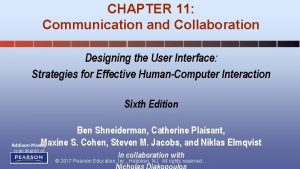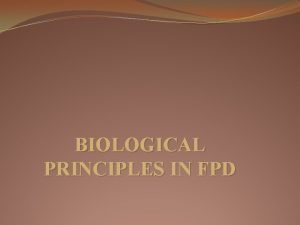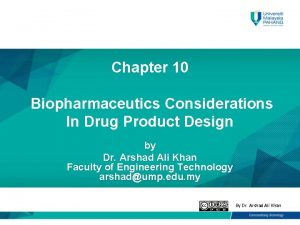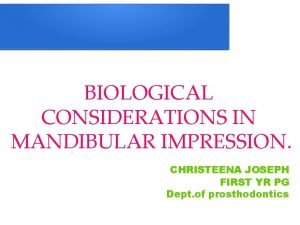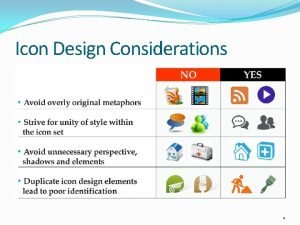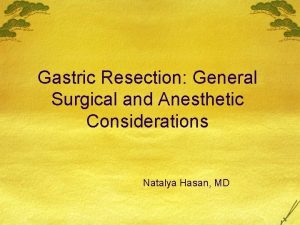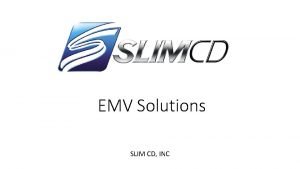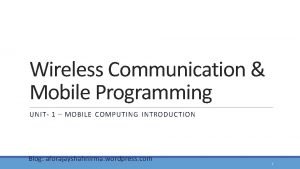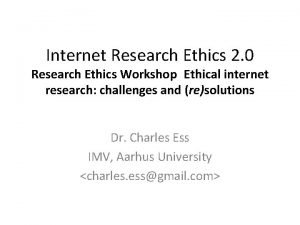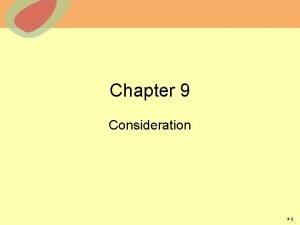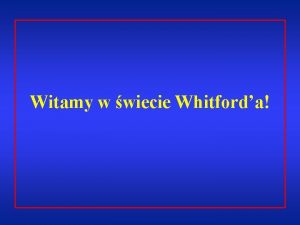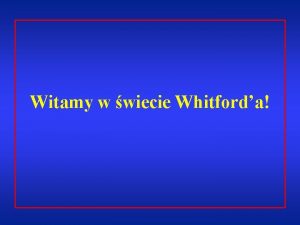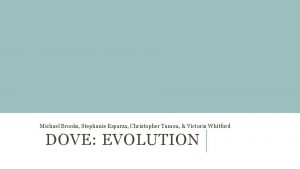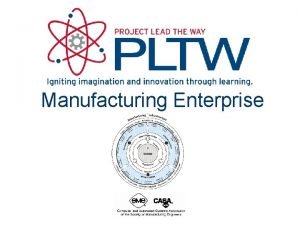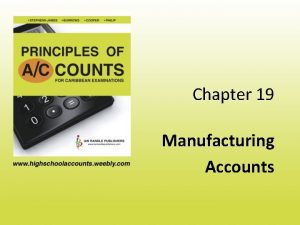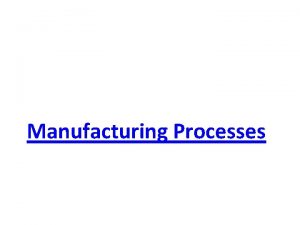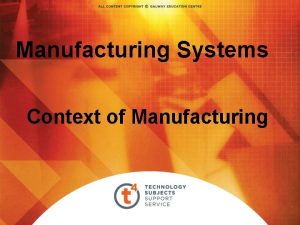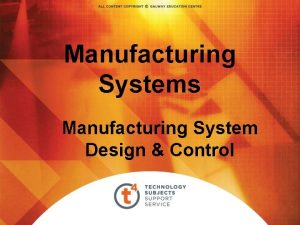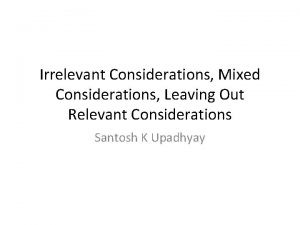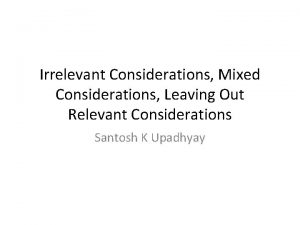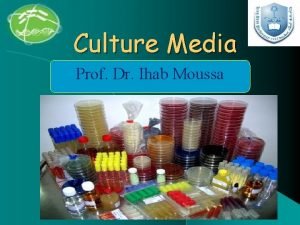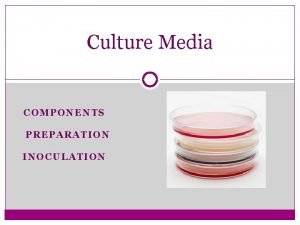Intensified manufacturing culture media development considerations William Whitford




































- Slides: 36

Intensified manufacturing culture media development considerations William Whitford Cell Culture GE Healthcare Imagination at work

Agenda • Continuous Manufacturing • Drivers for Continuous Manufacturing • Case Study 1 • Case Study 2 • Conclusion 2

Continuous manufacturing

The future of pharmaceutical manufacturing: what to expect in the next 25 years? • Intensified manufacturing approaches are being accepted • Growing interest in leveraging the benefits of continuous manufacturing into the biopharmaceutical industry • Industrial and academic researchers involved in development of continuous manufacturing • Cleaner, flexible, more efficient CM is encouraged by the EMA and FDA CM= Continuous Manufacturing EMA = Europien Medical Agency FDA = US Food and Drug Administration 29 -1442 -41 AA | March 2015 4

Intensified biomanufacturing High density perfusion • In distinct modes – Intensified batch – Continuous biomanufactruing • Many approaches and instruments – Culture parameter changes – Altered media circuits – Altered performance demands Optimized materials is an economic imperative 5

Why consider continuous manufacturing? General considerations: continuous vs batch General • General • Quality Flexibility Speed Quality Why consider continuous manufacturing? • Cost • Speed • Flexibility Cost 29 -1442 -41 AA | March 2015 6

Advantages to continuous biomanufacturing 29 -1442 -41 AA | March 2015 • • • • • • Supported by standards /regulatory agencies An established PAT /Qb. D friendly technology Faster and more robust process development Heightens processing parameter consistency Less failure from stressed mulitplex PID control Increases operational efficiency and capability Accepts materials /activity unavailable in batch Runs at higher molecular / metabolic efficiency Lowers process / reaction volume and times Provides increased process and flow flexibility Reduces equipment footprint and facility extent Reduces operator activities and intervention Increases overall facility utilization efficiency Reducing CPA and COG increases profitability Reduces initial build and equipment expenses Supports many sustainability / green initiatives Many limitations and concerns being alleviated Simplifies process / reduces wastage and loss Reduced material usage in process development Heightens operating material utilization efficiency Reduces intermediate and final product inventory 7

Enabling technologies for continuous manufacturing Single-use technology Process control Facility design Perfusion culture systems Cell culture medium design

Perfusion culture medium design Importance of cell culture medium performance on manufacturability • Many perfusion processes are based on maintaining a constant cellspecific perfusion rate (CSPR) • High CSPR: – medium not adapted to the cell metabolism – requires high volumetric perfusion – many medium components leave the bioreactor unmetabolized – operation not cost-efficient • Low CSPR: – the cell culture medium is meeting the cell lines nutritional needs 29 -1442 -41 AA | March 2015 MVC = million viable cells 9

Case study 1: perfusion media development

Perfusion medium development based on an existing fed-batch medium platform Scope Materials and methods To study combinations in an existing medium platform, consisting of medium and feeds, to develop a high performing perfusion medium Acti. CHO™ platform (Acti. CHO P medium, Acti. CHO Feed A and Acti. CHO Feed B) Ready. To. Process WAVE™ 25 system 2 L perfusion Cellbag™ bioreactor with floating filter MAb-producing cell line (licensed from Cellca Gmb. H) 29 -1442 -41 AA | March 2015 11

Experimental strategy Perfusion medium development Batch approach Steady-state approach Screening Do. E study Perfusion with steady-state conditions Optimization Do. E study Spent media analysis and new medium design Medium verification in perfusion Do. E = design of experiments 29 -1442 -41 AA | March 2015 12

Batch approach

BATCH APPROACH Screening Do. E study: design • Three factors: Viable cell (cv) concentrations – Acti. CHO™ P medium (50%, 75%, 100%) – Acti. CHO Feed A (0%, 5%, 10%, 15%) – Acti. CHO Feed B (0%, 0. 5%, 1. 5%) • Ten experiments, three replicates at Acti. CHO P 75%, Acti. CHO Feed A 10%, and Acti. CHO Feed B 1 % • D-optimal design, interaction model Clear potential that medium performance can be enhanced by the addition of feed solutions 29 -1442 -41 AA | March 2015 14

BATCH APPROACH Optimization Do. E study: results • Good models obtained for viable cell density (VCD) and titer Model statistics R 2 adj Q 2 RSD VCD 0. 84 0. 67 1. 88 Titer 0. 89 0. 78 146 • Sweet spot identified at – 7 1 % Acti. CHO™ P medium Contour plots for VCD and titer vs Acti. CHO P medium, Feed A, and Feed B concentrations VCD VCD Titer – 7. 5% Acti. CHO Feed A – 0. 9% Acti. CHO Feed B RSD = residual standard deviation 29 -1442 -41 AA | March 2015 15

BATCH APPROACH Medium verification in perfusion Perfusion run at 1 RV/d to determine the medium’s maximum performance q. P = cell-specific productivity MVC = million viable cells RV = reactor volume Window of opportunity identified: cv > 50 MVC/m. L, CSPR ≈ 20 p. L/c/d, q. P maintained at ≈ 20 pcd, NH 4 < 4 m. M, lactate < 0. 5 g/L, μ < 0. 2 d-1 29 -1442 -41 AA | March 2015 16

BATCH APPROACH Medium verification in perfusion Step 2: confirmation under steady-state conditions at ≈ 40 MVC/m. L and 1 RV/d ( = CSPR 25) MVC = million viable cells RV = reactor volume 29 -1442 -41 AA | March 2015 17

Steady-state approach

STEADY-STATE APPROACH Perfusion with steady-state conditions Objective • Measure cell specific productivity and amino acid consumption rates as the perfusion rate is decreased stepwise from 100 to 25 p. L/c/d. Illustration of experimental strategy in steady-state approach • Use information to design perfusion medium 29 -1442 -41 AA | March 2015 19

STEADY-STATE APPROACH Spent media analysis and new medium design Impact of the cell-specific perfusion rate (CSPR) on the cellspecific productivity (q. P) 29 -1442 -41 AA | March 2015 20

STEADY-STATE APPROACH Spent media analysis and new medium design Impact on CSPR on amino acid consumption: heat map for seven limiting amino acids at different CSPR Amino acid Acti. CHO™ supplement ASN Feed A SER Feed A GLY - ARG Feed A PRO Feed A TYR Feed B LYS Feed A CSPR (p. L/c/d) 101. 1 84. 9 82. 3 76. 8 75. 8 70 66. 3 43. 4 25. 4 Between 2 0 % and 3 0 % of initial Acti. CHO P medium Below 2 0 % of initial Acti. CHO P medium 29 -1442 -41 AA | March 2015 21

STEADY-STATE APPROACH Spent media analysis and new medium design Example of amino acid concentrations (asparagine) as function of the cell-specific perfusion rate (CSPR) 29 -1442 -41 AA | March 2015 22

STEADY-STATE APPROACH Spent media analysis and new medium design Conclusion Enhance Acti. CHO™ P medium with • Acti. CHO Feed A: 7 % • Acti. CHO Feed B: 1 % 29 -1442 -41 AA | March 2015 23

STEADY-STATE APPROACH Medium verification in perfusion Step 1: Perfusion run at 1 RV/d to determine the maximum performance RV = reactor volume Window of opportunity identified: cv > 50 MVC/m. L, CSPR ≈ 20 p. L/c/d, q. P maintained at ≈ 30 pcd, NH 4 < 4 m. M, lactate < 0. 5 g/L, μ < 0. 2 d-1 29 -1442 -41 AA | March 2015 24

STEADY-STATE APPROACH Medium verification in perfusion Step 2: confirmation under steady-state conditions at 50 MVC/m. L and 1 RV/d ( = CSPR 20) MVC = million viable cells RV = reactor volume 29 -1442 -41 AA | March 2015 25

Case Study 2: T-Cells in perfusion

T-CELLS Perfusion with steady-state set-up Objective • Employ a Xuri. TM Cell Expansion System W 25 rocking bioreactor • Compare batch and perfusion culture • Study relative impact of perfusion 29 -1442 -41 AA | March 2015 27

T-CELLS Perfusion with steady-state set-up Methods • Expansion of T-Cells – T 225 flasks – CD 3/CD 28 beads – >day 3: cells kept @ 0. 5 x 106 • Day 5 post expansion – Xuri 2 L Cellbag. TM perfusion reactor – Count kept at 0. 5 x 106 until 1 L volume • Perfusion initiated at 2. 0 x 106 – Perfusion rate per cell concentration Xuri™ Cellbag™ bioreactor – Through 2. 0 x 1010 as in Results 29 -1442 -41 AA | March 2015 28

T-CELLS Perfusion with steady-state results Perfusion culture effects • Delays T-cell culture arrest • Extends T-cell culture viability • Supports much higher culture densities 29

T-CELLS Perfusion with steady-state results Metabolite effects • Effectively restores primary metabolites • Efficiently removes undesired secondary metabolites • Equally effective for growth factors, hormones and co-factors. 29 -1442 -41 AA | March 2015 30

STEADY-STATE APPROACH Perfusion at different rates as a tuning fork for MAb product quality Analytical technology Analyte Acidic variants Fed-batch > 60% 20 p. L/c/d 25% 43 p. L/c/d 23% 77 p. L/c/d 19% 90 p. L/c/d 12% Alkaline variants 3% 2% 4% 4% 4% SEC Aggregate 1% 0. 4% 0. 3% 0. 2% 0. 5% Glycan map G 0 F 35% n. a. 36% G 1 F 41% n. a. 45% G 2 F 15% n. a. 14% Man 5 3% n. a. 1% 5. 2 105 Ms -1 3. 82 + 0. 07 105 Ms -1 n. a. 14. 9 10 -5 s-1 8. 64 + 0. 72 10 -5 s-1 n. a. 287 p. M 226 p. M n. a. CIEX TNF-α binding On rate, ka kinetics* Off rate, kd Affinity, KD * Results obtained using Biacore™ T 200 processing unit and Sensor Chip Protein A SEC = size exclusion chromatography, n. a. = not analyzed CIEX = cation exchange chromatography 29 -1442 -41 AA | March 2015 31

Perfusion study conclusions

Conclusions Batch and steady-state approaches • Presented to develop high performing perfusion media from an existing medium platform • Easily applicable for other cell culture media • Serves as a fast route to an efficient upstream perfusion process • Has great potential to meet many of tomorrow’s demands within biopharmaceutical manufacturing, when combined with a continuous downstream operation 29 -1442 -41 AA | March 2015 33

Conclusions The steady-state approach • Showed highly improved performance, using twice the development time, compared with the batch approach • Resulted in a final process with more than a 7 5 % decrease in cell-specific perfusion rate (CSPR), compared with the starting process conditions (20 compared to 90 p. L/cell/d) 29 -1442 -41 AA | March 2015 34

Thank You GE Healthcare Bio-Sciences AB, a General Electric company. Björkgatan 30 751 84 Uppsala Sweden GE, imagination at work and GE monogram are trademarks of General Electric Company. Hy. Clone, Cell Boost, Acti. CHO, Xuri, and Cellbag are a trademark of General Electric Company or one of its subsidiaries. © 2014 General Electric Company – All rights reserved. All goods and services are sold subject to the terms and conditions of sale of the company within GE Healthcare which supplies them. A copy of these terms and conditions is available on request. Contact your local GE Healthcare representative for the most current information.

 Henry whitford
Henry whitford Bioreactor considerations for animal cell culture
Bioreactor considerations for animal cell culture Trade routes intensified
Trade routes intensified Intensified hypnic jerks
Intensified hypnic jerks Closing of the western frontier
Closing of the western frontier Manufacturing cost vs non manufacturing cost
Manufacturing cost vs non manufacturing cost Process costing definition
Process costing definition Manufacturing cost vs non manufacturing cost
Manufacturing cost vs non manufacturing cost Manufacturing cost vs non manufacturing cost
Manufacturing cost vs non manufacturing cost Additive manufacturing vs subtractive manufacturing
Additive manufacturing vs subtractive manufacturing Manufacturing social media
Manufacturing social media Durite
Durite Tax considerations for setting up a new business
Tax considerations for setting up a new business Atm kiosk solution
Atm kiosk solution Exchange transaction and relationship in marketing
Exchange transaction and relationship in marketing Mechanical design of transmission line
Mechanical design of transmission line Database design considerations
Database design considerations Contrasting acquisition
Contrasting acquisition Cloud delivery model
Cloud delivery model Writing strategies and ethical considerations
Writing strategies and ethical considerations What is basal state in phlebotomy
What is basal state in phlebotomy Collaboration design considerations
Collaboration design considerations Principles of tooth preparation fpd
Principles of tooth preparation fpd Anatomical considerations
Anatomical considerations Biopharmaceutic considerations in drug product design
Biopharmaceutic considerations in drug product design Mylohyoid curtain
Mylohyoid curtain Dogso e spa
Dogso e spa Final design icon
Final design icon Environmental considerations pdhpe
Environmental considerations pdhpe Spurt and shunt muscles
Spurt and shunt muscles Quasi experimental design ethical issues
Quasi experimental design ethical issues Emv kiosk considerations
Emv kiosk considerations Design considerations for mobile computing
Design considerations for mobile computing Appendices example in research paper
Appendices example in research paper O2 liters to fio2
O2 liters to fio2 Ethical considerations examples
Ethical considerations examples Considerations examples
Considerations examples

